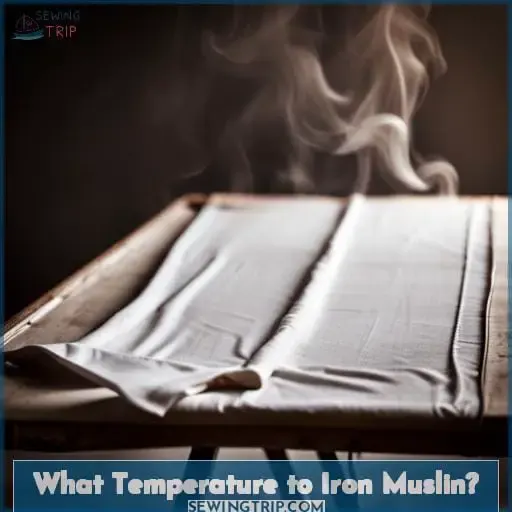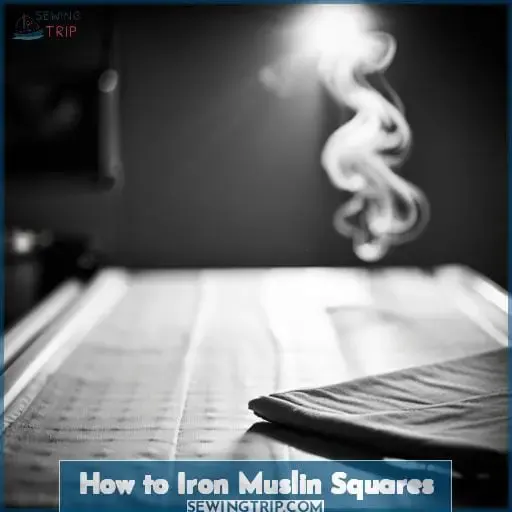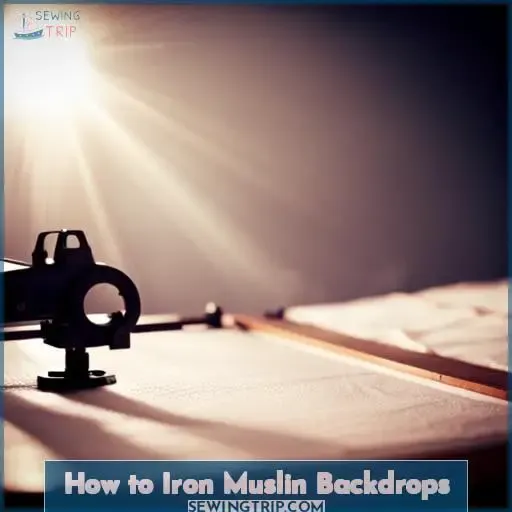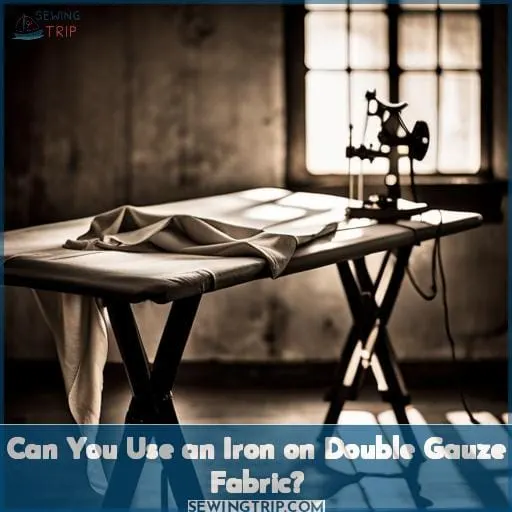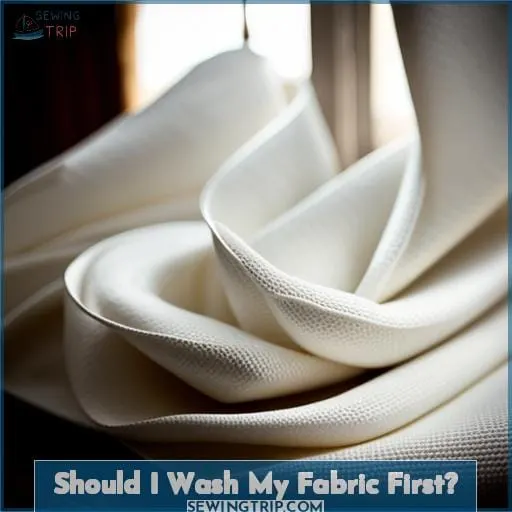This site is supported by our readers. We may earn a commission, at no cost to you, if you purchase through links.
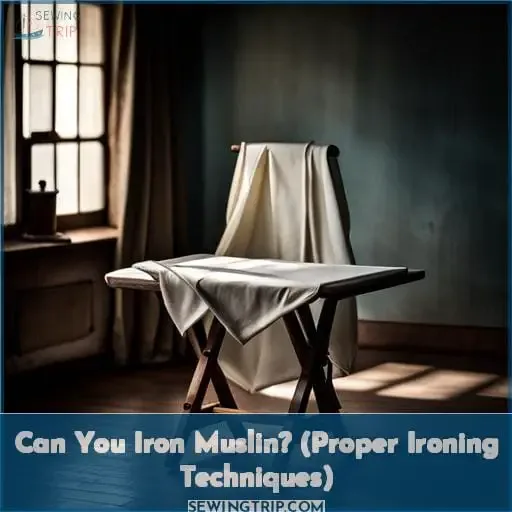 You may be wondering if it’s possible to iron muslin fabric. The answer is yes – with the right techniques, you can smooth out wrinkles in this delicate material.
You may be wondering if it’s possible to iron muslin fabric. The answer is yes – with the right techniques, you can smooth out wrinkles in this delicate material.
Let’s use Gina as an example. She recently had to make muslin curtains for her living room but struggled to remove all the wrinkles without damaging the fabric. After researching, she learned proper methods to iron muslin so it looked brand new.
Here’s what we’ll cover:
- Can You Iron Muslin Fabric?
- What Temperature to Use for Ironing Muslin
- Can You Steam Press Muslin?
- How to Iron Muslin Squares
- Tips for Ironing Muslin Backdrops
- Using an Iron on Double Gauze Fabric
- Where to Buy Double Gauze Fabric
- Recommended Size for Swaddle Blankets
- Should Fabric Be Pre-Washed?
With these tips in mind, let’s get started on mastering those muslins! Proper techniques will turn wrinkled fabric into something smooth and presentable.
Table Of Contents
- Key Takeaways
- Can You Iron Muslin Fabric?
- What Temperature to Iron Muslin?
- Can You Steam Muslin?
- How to Iron Muslin Squares
- Can You Iron Muslin Backdrops?
- How to Iron Muslin Backdrops
- Can You Use an Iron on Double Gauze Fabric?
- Where Can I Buy Double Gauze Fabric?
- What Size Should a Swaddle Blanket Be?
- Should I Wash My Fabric First?
- Conclusion
Key Takeaways
- Iron muslin at a temperature of 280-300°F using the cotton or linen setting.
- Before ironing, dampen the muslin squares and press from selvage to selvage.
- For double gauze fabric, iron at 250-300°F with a damp cloth to prevent excessive heat.
- Steaming is a gentle, effective method for removing wrinkles from large muslin backdrops.
Can You Iron Muslin Fabric?
With wrinkle management vital, consider steaming your large muslin backdrop while ironing smaller swatches. For creased photo backdrops, drag that shower rod out of the bathroom! Simply hang the muslin, delicately mist it, then blast wrinkles away with a hot steam iron on the cotton setting.
As the steam penetrates each fiber, marvel at the transformation from crumpled mess to pristine perfection.
Smaller folded muslin pieces like quilting squares or gift wrap benefit more from ironing. Lay them smoothly on the board, lightly dampen, and run a preheated iron across the surface. With higher heat concentration, ironing crisps up edges and crevices steam struggles to reach.
Mind the type and size when caring for muslin. And with a few easy steps, achieve smooth, beautiful fabric ready for any use.
What Temperature to Iron Muslin?
After tackling muslin wrinkles with a steamer, grab the iron. Ironing precisely targets individual creases in smaller muslin pieces. First, set your iron to the cotton or linen setting, around 280-300°F. Anything hotter risks scorching the delicate fabric.
Dampen the muslin first for easier wrinkle release; the moisture helps the fibers relax. Lay the fabric smoothly on your board and iron slowly selvage to selvage. Let sections dry before re-dampening to avoid water marks.
Don’t overdo the heat—just enough to banish bumps. With a careful iron at the right temperature, you’ll restore your fabric to smooth glory. Remember, muslin irons beautifully, but too much heat destroys its delicate nature.
Can You Steam Muslin?
Yes, you can steam muslin to get wrinkle-free backdrops. Steaming is an effective method for removing wrinkles from large muslin backdrops or fabric yardage.
- Hang the muslin on a shower rod or clothesline before steaming. This allows the fabric to hang freely so wrinkles can relax.
- Use a fabric steamer if you have one. Clothing steamers distribute steam evenly across the surface.
- Hold the steamer head about an inch from the fabric. Slowly move it up and down the muslin piece to relax wrinkles.
- Focus on problem areas but steam the entire surface for best results.
Steaming is gentler than ironing for wrinkle removal. It allows the fibers to relax gradually without damaging the fabric. Proper muslin care like steaming maintains a smooth, wrinkle-free surface for photo backdrops and projects.
How to Iron Muslin Squares
Dampen the squares before running a heated iron over them from selvage to selvage. Removing wrinkles from muslin squares ensures your finished project has a crisp, professional look.
- Set the iron to the cotton setting and allow it to fully heat. Cotton/linen is ideal for muslin.
- Lightly mist the squares with water to dampen them. This allows the heat to penetrate the fibers.
- Place squares one at a time on the ironing board, smoothing them flat.
- Position the iron at one selvage and press firmly while slowly moving across to the opposite selvage.
Repeat as needed until the squares lie flat and wrinkle-free. Proper technique prevents damaging the fabric. With practice, you’ll achieve smooth, pristine muslin for all your sewing and crafting creations.
Can You Iron Muslin Backdrops?
Don’t let your muslin backdrop get wrinkled in the first place – use a sturdy support system. For smooth, pristine muslin photography backdrops, care and preventive measures are key. Once wrinkled, muslin can be stubborn to iron without damaging the fabric. Instead, focus on proactive steps: use a taut backdrop stand and avoid letting the fabric drag on the floor.
Handle gently, storing flat if possible. If wrinkles do develop, steaming is gentler than ironing for large muslin backdrops. With plenty of room, hang the muslin and apply a steamer in long strokes. Let it air dry taut for crisp, professional portraits every time.
For smaller pieces, iron with a damp cloth on low heat. With some care and attention, your muslin will maintain its smooth, photo-ready sheen.
How to Iron Muslin Backdrops
Rejuvenate your light-as-air muslin background by pressing it smooth as glass.
Start with clean, dry muslin. Dampen it slightly with a spray bottle, then lay it flat on your ironing board. Set a steam iron to the cotton/linen setting. Glide it slowly over the entire surface, flipping and re-dampening as needed.
For stubborn wrinkles, use a pressing cloth. Lay the cloth over the wrinkle and apply firm pressure with the iron.
Between sessions, roll up your backdrop around a tube to keep it smooth. Store flat if possible.
With a little steam, elbow grease and care, your muslin backdrop will stay pristine through countless photo shoots. The flattering, wrinkle-free drape is perfect for portraits. Care for your canvas, and it’ll be a trusty companion behind beautiful images for years to come.
Can You Use an Iron on Double Gauze Fabric?
You’re able to revive double gauze’s soft drape with a quick press of the iron. Set your iron to the cotton or linen setting, around 250-300F. Make sure the fabric is slightly damp before beginning. Lay it face down on the ironing board and press gently in long strokes, working section by section.
Lift and reposition the fabric often, being careful not to leave creases. For extra crinkly texture, bunch areas up tightly in your hand before ironing. When pressing seams, use a pressing cloth to avoid imprinting them onto the right side.
Take care not to apply too much heat, as it can damage the fabric’s loft and cause shrinkage. With some steam and a light touch, you’ll bring your double gauze back to its lightweight, gauzy glory. Whether making blankets, clothes or home decor, handle this delicate fabric with care and you’ll be rewarded with billowy, airy projects that feel as good as new.
Where Can I Buy Double Gauze Fabric?
There’re tons of places online to grab double gauze fabric for your latest project.
- Etsy shops like OhSewPrettyByTammy boast gorgeous double gauze fabric options from independent sellers, letting you find rare prints while supporting small businesses.
- Large retailers like JOANN Fabrics offer major brands of double gauze like rileyblake designs and Birch Fabrics at affordable prices, especially with coupons and sales.
- Sites like fabric.com provide a huge inventory of double gauze fabric types, making it easy to find specific materials and compare selections before you buy.
With many sources to buy quality double gauze fabric online for everything from baby blankets to nursery decor and other baby crafts, you can find the perfect prints and materials for your next sewing or quilting project.
Just be sure to follow the proper care instructions when washing delicate double gauze fabric before gifting any handmade baby gifts.
What Size Should a Swaddle Blanket Be?
You’ll want to choose swaddles around 36-40 inches square for optimal newborn comfort. Smaller swaddles won’t allow for a snug wrap, while larger ones take more fabric and create excess bulk. Stick to lightweight, breathable cottons or muslin – they’re gentle on delicate skin while still providing that cozy, womb-like feel baby loves.
Be sure to leave room for hip and leg movement but wrap the arms in so those startle reflexes don’t wake baby up. Always place baby on their back and check for overheating. Swaddling is absolutely magical for calming fussy infants and helping them (and you!) get some much-needed rest.
With the right size swaddle and technique, your little one will drift off to dreamland in no time.
Should I Wash My Fabric First?
You ought to pre-wash most fabric before starting a sewing project. Pre-washing is crucial for preventing shrinkage and future wrinkling in finished garments.
There are 4 key reasons to pre-wash fabric:
- Removes factory residues. New fabric often has starch or sizing from manufacturing.
- Checks for dye bleeding. Pre-washing identifies problematic dyes before construction begins.
- Preshrinks the fabric. Fabrics shrink at varying rates. Machine washing preshrinks material so your sewn item maintains its shape and size through laundering.
- Prevents wrinkling. Washing relaxes fibers and allows the fabric to take final shape.
Following proper pre-ironing preparation and fabric washing techniques now saves headaches later. Sewing projects benefit from smooth, pre-shrunk, wrinkle-resistant fabric cared for before the first stitch.
Conclusion
So there you have it – you can iron muslin. The answer is a resounding yes! With the right temperature and technique, you can easily achieve a wrinkle-free fabric that looks as good as new. Before taking out the iron, make sure to check the fabric for any special instructions, and always remember to wash your material before ironing.
And don’t forget, if you need a backdrop or swaddle blanket that won’t wrinkle, you can always opt for a paper backdrop or double gauze fabric. With these tips, you’ll be sure to get the perfect fabric for your next project.


